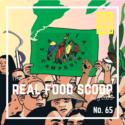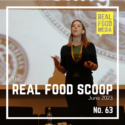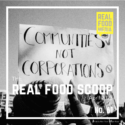by Anna Lappé
At the turn of the last century, the father of public relations, Edward Bernays, launched the Celiac Project, whose medical professionals recommended bananas to benefit celiac disease sufferers. Those pitched on the sweet fruit’s miraculous properties didn’t know the project was actually created for the United Fruit Co., the largest trader of bananas in the world.
The creation of front groups — independent-sounding but industry-backed organizations — as a public relations strategy dates at least as far back as Bernays’ day. But a new report by Kari Hamerschlag, a senior program manager at the environmental nonprofit Friends of the Earth; Stacy Malkan, a co-founder of the food industry watchdog US Right to Know; and me shows that such tactics are continuing with ever more scope and scale today.
The report, released today, exposes the growth of food-industry-sponsored front groups and other covert communication tactics in the past few years. While food industry spin is not new, we’re seeing an unprecedented level of spending and deployment of an ever wider array of PR tactics. We argue this rise of industrial food spin is a direct response to mounting public concerns about industrial agriculture as well as a growing interest in sustainable food and groundswell for organic products.
Increasingly, the American public is raising questions about toxic chemicals used in farming, routine antibiotics used in livestock production and genetic engineering in agriculture. The booming organic food business is one sign: Sales of organic food and products in the United States are projected to jump from $35 billion in 2013 to $170 billion in 2025 — a direct threat to the profits of the processed food, animal agriculture and chemical industries engaging in such spin. According to a recent Fortune article, since 2009 the 25 biggest food and beverage companies — selling nonorganic processed and junk food — lost an equivalent of $18 billion in market share. “I would think of them like melting icebergs,” the article quotes Credit Suisse analyst Robert Moskow as saying. “Every year they become a little less relevant.”
In the face of this threat, we argue that the industrial food sector — from the biotech behemoths to the animal agriculture industry — is working overtime to defuse these concerns with well-funded communication efforts and a rash of new front groups. From 2009 to 2013, just 14 of these front groups spent $126 million to shape the story of food while presenting the veneer of independence. There’s the Alliance to Feed the Future, which produces Common Core–vetted curricula on healthy food for public schools. Its members include the Frozen Pizza Institute and the Calorie Control Council, which promotes the benefits of Olestra and saccharin, among other artificial sweeteners and fats. You don’t need to be an expert in food security to be skeptical to take advice about feeding the world from the trade council for fake sugar and fat.
We detail groups such as the U.S. Farmers and Rancher’s Alliance (USFRA) — whose goal, it says, is “to enhance U.S. consumer trust in modern food production to ensure the abundance of affordable, safe food” and whose lead partners include animal pharmaceutical company Elanco, biotech giant Monsanto and chemical companies DuPont, Dow and Syngenta. Among the USFRA’s communication priorities since its launch in 2011 has been to combat growing public concern about the routine use of antibiotics in animal agriculture. Its Antibiotics Working Group has developed educational materials, hosted public conversations and trained media representatives to downplay the risks of antibiotics. But the group’s messages contradict well-documented evidence of the widespread misuse of routine antibiotics. Today 70 percent of medically important antibiotics sold in the United States are used not in humans, according to the Food and Drug Administration, but in livestock animal production to promote growth or prevent disease, leading to the threat of antibiotic-resistant bacteria.
But it’s not just front groups. We describe a plethora of other communication tactics, many of them so under-the-radar that often people don’t realize the stories are being crafted behind the scenes. We describe how the industrial food sector targets female audiences and co-opts female bloggers, how industry groups pay for advertisements to look like editorial content and how the industry infiltrates social media. In one example, the Biotechnology Industry Organization hired PR firm Ketchum to develop GMOAnswers.com, populated with industry-approved answers about genetically modified organisms. The firm even won a prestigious advertising award for this campaign, particularly for its success in tracking negative tweets about GMOs and engaging users directly, urging them to visit the website.
The trade groups for the industrial food sector also reach into their deep pockets to shape how the media report on our food system. In our analysis, we found that just four major trade associations for the chemical, biotech and animal agriculture sectors had expenses totaling half a billion dollars from 2009 to 2013, including communications and marketing campaigns.
These are just some of the tactics we describe. While it is far from a comprehensive documentation of every front group or tactic, we hope the report inspires everyday Americans, public officials and journalists to be critical consumers of the stories we hear about food and farming. Particularly at a time when mainstream media outlets are hemorrhaging, cutting back on the resources available for the investigative pieces essential to accurate reporting on and exposing industry malfeasance, it’s increasingly important that we know where our food information comes from and who is behind it. There’s new indication of the importance of this every day. Consider how the food industry is already busy pushing back in the media against the sound recommendations from the scientific advisory committee for the government’s Dietary Guidelines for Americans, set to be finalized later this year.
We must ensure these PR strategies don’t leave us in the dark about the real story of our food. Because as we debate one of the biggest questions of our time — how to feed ourselves safely and sustainably — it’s essential we base critical policy decisions and consumer choices on substance, not spin.
Originally published in Al Jazeera America




